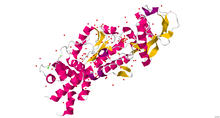- cyaA
-
Bifunctional hemolysin-adenylate cyclase precursor 
Crystal structure of the N-terminal adenylyl cyclase domain (ACD) of B. pertussis cyaA complexed with the C-terminal domain of Xenopus calmodulin.[1] Identifiers Symbol cyaA Entrez 2661688 PDB 2COL UniProt P15318 Other data EC number 4.6.1.1 Bifunctional hemolysin/adenylate cyclase is a protein that in B. pertussis (the bacteria that causes whooping cough) is encoded by the cyaA gene. This protein in turn is cleaved into a calmodulin-sensitive adenylate cyclase (cyaA–ACD) and hemolysin. Both are virulence factors facilitating respiratory tract colonization by B. pertussis.[2] The cyaA–ACD binds to a M2 integrin cell surface receptor and inserts its N-terminal adenylyl cyclase domain into the cytosol.[3] After binding to calmodulin, cyaA–ACD catalyzes the cyclization of AMP into cAMP. This catalysis raises the intracellular concentration of cAMP to toxic levels.[4]
Contents
Structure
Four discrete regions of CyaA bind calcium-loaded calmodulin with a large buried contact surface. Of those, a tryptophan residue (W242) at an alpha-helix of CyaA makes extensive contacts with the calcium-induced, hydrophobic pocket of calmodulin. Mutagenic analyses show that all four regions of CyaA contribute to calmodulin binding and the calmodulin-induced conformational change of CyaA is crucial for catalytic activation. A crystal structure of CyaA-calmodulin with adefovir diphosphate, the metabolite of an approved antiviral drug, reveals the location of catalytic site of CyaA and how adefovir diphosphate tightly binds CyaA. The ACD of CyaA shares a similar structure and mechanism of activation with anthrax edema factor (EF). However, the interactions of CyaA with calmodulin completely diverge from those of EF. This provides molecular details of how two structurally homologous bacterial toxins evolved divergently to bind calmodulin, an evolutionarily conserved calcium sensor.[1]
Chemistry
CyaA binds to calcium ions selectively and non-covalently, along with other proteins and protein complexes. It has also been shown to interact with one or more specific sites on a receptor molecule, a macromolecule that combines with a hormone, neurotransmitter, drug, or intracellular messenger to initiate a change in cell function.[1]
See also
References
- ^ a b c PDB 2COL; Guo Q, Shen Y, Lee YS, Gibbs CS, Mrksich M, Tang WJ (September 2005). "Structural basis for the interaction of Bordetella pertussis adenylyl cyclase toxin with calmodulin". EMBO J. 24 (18): 3190–201. doi:10.1038/sj.emboj.7600800. PMC 1224690. PMID 16138079. http://www.pubmedcentral.nih.gov/articlerender.fcgi?tool=pmcentrez&artid=1224690.
- ^ Carbonetti NH, Artamonova GV, Andreasen C, Bushar N (May 2005). "Pertussis toxin and adenylate cyclase toxin provide a one-two punch for establishment of Bordetella pertussis infection of the respiratory tract". Infect. Immun. 73 (5): 2698–703. doi:10.1128/IAI.73.5.2698-2703.2005. PMC 1087369. PMID 15845471. http://www.pubmedcentral.nih.gov/articlerender.fcgi?tool=pmcentrez&artid=1087369.
- ^ Guermonprez P, Khelef N, Blouin E, Rieu P, Ricciardi-Castagnoli P, Guiso N, Ladant D, Leclerc C (May 2001). "The adenylate cyclase toxin of Bordetella pertussis binds to target cells via the alpha(M)beta(2) integrin (CD11b/CD18)". J. Exp. Med. 193 (9): 1035–44. doi:10.1084/jem.193.9.1035. PMC 2193436. PMID 11342588. http://www.pubmedcentral.nih.gov/articlerender.fcgi?tool=pmcentrez&artid=2193436.
- ^ Ladant D, Ullmann A (April 1999). "Bordatella pertussis adenylate cyclase: a toxin with multiple talents". Trends Microbiol. 7 (4): 172–6. doi:10.1016/S0966-842X(99)01468-7. PMID 10217833.

This protein-related article is a stub. You can help Wikipedia by expanding it.
